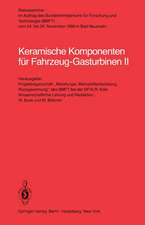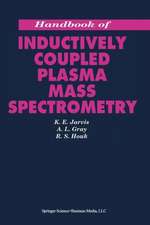Handbook of Photonics for Biomedical Engineering
Editat de Aaron Ho-Pui Ho, Donghyun Kim, Michael G. Somekhen Limba Engleză Hardback – 10 apr 2017
Preț: 5185.37 lei
Preț vechi: 5458.29 lei
-5% Nou
Puncte Express: 7778
Preț estimativ în valută:
992.19€ • 1038.73$ • 820.99£
992.19€ • 1038.73$ • 820.99£
Carte tipărită la comandă
Livrare economică 01-07 aprilie
Preluare comenzi: 021 569.72.76
Specificații
ISBN-13: 9789400750517
ISBN-10: 940075051X
Pagini: 1500
Ilustrații: XXI, 947 p. 491 illus., 395 illus. in color.
Dimensiuni: 155 x 235 x 59 mm
Greutate: 1.91 kg
Ediția:1st ed. 2017
Editura: SPRINGER NETHERLANDS
Colecția Springer
Locul publicării:Dordrecht, Netherlands
ISBN-10: 940075051X
Pagini: 1500
Ilustrații: XXI, 947 p. 491 illus., 395 illus. in color.
Dimensiuni: 155 x 235 x 59 mm
Greutate: 1.91 kg
Ediția:1st ed. 2017
Editura: SPRINGER NETHERLANDS
Colecția Springer
Locul publicării:Dordrecht, Netherlands
Public țintă
ResearchCuprins
3D optical trapping studies of motor proteins.- Adaptive optics for aberration correction in optical microscopy.- Advances in super-resolution microscopy.- Application of diffuse optical spectroscopies on therapy monitoring by blood flow and oxygenation quantification.-
Application of ultrashort-pulsed lasers for optical manipulation of biological functions.- Applications of Imaging to Drug Development in the Pharmaceutical Industry.- Cadmium-free quantum dots for biophotonic imaging and sensing.- Development of extraordinary optical transmission based techniques for biomedical applications.-
Exploiting complex media for biomedical applications.- Fiber optical tweezers for manipulation and sensing of bioparticles.- Fluorescence lifetime imaging.- Functional metal nanocrystals for biomedical applications.- High resolution optical microscopy for biological applications.- Highly sensitive sensing with high-Q whispering gallery microcavities.- In-vivo flow cytometry usingnear-infrared confocal microscopy.- Lab-on-a-chip device and system for point-of-care applications.- Laser Micromachining of Highly Functionalized Microcantilever Sensor Arrays.- Localized surface plasmon microanalysis.- Micro-Optical Sectioning Tomography.- Multifunctional Photoacoustic Tomography.- Multimodal multiphoton imaging and Raman spectral assessment of chronic liver diseases.-
New approaches for high speed in-vitro cardiac imaging.- Nonlinear multi-modal optical imaging.- Optical and Optoacoustic Imaging in the Diffusive Regime.- Optical manipulation and sensing in a microfluidic device.- Optical Tweezers-Based Microrheology of Soft Materials and Living Cells.- Optical vortices for biophotonics.-
Optofluidic Biosensors.- Phase-Sensitive Optical Coherence Tomography.- Photodynamic therapy.- Photonic crystal fiber based biosensors.- Probing different biological length scales using photoacoustics: from 1-1000 MHz.- Rapid three dimensional imaging of living
cells.- Retinal imaging.- SERS for Biosensing Applications.-
SPR biosensors.- Surface plasmon enhanced super-localization microscopy.- Surface plasmon enhanced TIRF or full field imaging with supercritical angle fluorescence.
Application of ultrashort-pulsed lasers for optical manipulation of biological functions.- Applications of Imaging to Drug Development in the Pharmaceutical Industry.- Cadmium-free quantum dots for biophotonic imaging and sensing.- Development of extraordinary optical transmission based techniques for biomedical applications.-
Exploiting complex media for biomedical applications.- Fiber optical tweezers for manipulation and sensing of bioparticles.- Fluorescence lifetime imaging.- Functional metal nanocrystals for biomedical applications.- High resolution optical microscopy for biological applications.- Highly sensitive sensing with high-Q whispering gallery microcavities.- In-vivo flow cytometry usingnear-infrared confocal microscopy.- Lab-on-a-chip device and system for point-of-care applications.- Laser Micromachining of Highly Functionalized Microcantilever Sensor Arrays.- Localized surface plasmon microanalysis.- Micro-Optical Sectioning Tomography.- Multifunctional Photoacoustic Tomography.- Multimodal multiphoton imaging and Raman spectral assessment of chronic liver diseases.-
New approaches for high speed in-vitro cardiac imaging.- Nonlinear multi-modal optical imaging.- Optical and Optoacoustic Imaging in the Diffusive Regime.- Optical manipulation and sensing in a microfluidic device.- Optical Tweezers-Based Microrheology of Soft Materials and Living Cells.- Optical vortices for biophotonics.-
Optofluidic Biosensors.- Phase-Sensitive Optical Coherence Tomography.- Photodynamic therapy.- Photonic crystal fiber based biosensors.- Probing different biological length scales using photoacoustics: from 1-1000 MHz.- Rapid three dimensional imaging of living
cells.- Retinal imaging.- SERS for Biosensing Applications.-
SPR biosensors.- Surface plasmon enhanced super-localization microscopy.- Surface plasmon enhanced TIRF or full field imaging with supercritical angle fluorescence.
Notă biografică
Dr. Donghyun Kim received a B. S. with summa cum laude and an M. S. from Seoul National University in 1993 and 1995, respectively, both in electronics engineering. He graduated from the Massachusetts Institute of Technology, MA, U.S.A. in 2001 with a Ph. D. in electrical engineering in the area of novel multi-dimensional display technologies and smart optical filters developed for military applications. He worked on next generation fiber-optic access communication systems at Photonic Research and Test Center, Somerset, NJ, of Corning Inc. as a senior research scientist and then investigated cellular biophotonic sensors for in vitro cell culture devices at Department of Chemical and Biomolecular Engineering of Cornell University, Ithaca, NY, as a postdoctoral fellow. Since 2004, He has been in charge of Biophotonics Engineering Laboratory of Yonsei University, Seoul, Korea. He served as program chair for the Information Technology Program of Underwood International College, Yonsei University and has directed the Yonsei Institute of Medical Instruments Technology.
The main theme of his research has been fundamental studies of nanophotonic technology and applications in biomedical engineering with an emphasis on plasmonic techniques. Plasmonics rapidly emerges as a novel toolbox that would allow highly sensitive nanosensors as well as imaging platforms with super-resolution. He has given 40+ invited lectures on related topics and written more than 100 peer-reviewed journal and conference publications on nano and biophotonics, many of which were the results of collaboration with researchers of diverse backgrounds across the world. He also holds 21 international patents and works closely with many renowned industrial partners in the area. In recognition of the research achievements, He was awarded a Korean Research Foundation Young Investigator Award in 2005, LG Scholar Fellowship in 2009, and recently Leap Research Award, one of the most pres
tigious funding awards from the National Research Foundation of Korea, in 2011. He has organized many local and international conferences in the field of nano/biophotonics including Asian and Pacific Rim Symposium on Biophotonics, Surface Plasmon Photonics 2011, and SPIE Global Congress on Nanosystems in Engineering and Medicine 2012. He has also held visiting researcher appointments at Rutgers University, State University of New Jersey, and University of California at Irvine.. He has organized many local and international conferences in the field of nano/biophotonics including Asian and Pacific Rim Symposium on Biophotonics, Surface Plasmon Photonics 2011, and SPIE Global Congress on Nanosystems in Engineering and Medicine 2012. He has also held visiting researcher appointments at Rutgers University, State University of New Jersey, and University of California at Irvine.
The main theme of his research has been fundamental studies of nanophotonic technology and applications in biomedical engineering with an emphasis on plasmonic techniques. Plasmonics rapidly emerges as a novel toolbox that would allow highly sensitive nanosensors as well as imaging platforms with super-resolution. He has given 40+ invited lectures on related topics and written more than 100 peer-reviewed journal and conference publications on nano and biophotonics, many of which were the results of collaboration with researchers of diverse backgrounds across the world. He also holds 21 international patents and works closely with many renowned industrial partners in the area. In recognition of the research achievements, He was awarded a Korean Research Foundation Young Investigator Award in 2005, LG Scholar Fellowship in 2009, and recently Leap Research Award, one of the most pres
tigious funding awards from the National Research Foundation of Korea, in 2011. He has organized many local and international conferences in the field of nano/biophotonics including Asian and Pacific Rim Symposium on Biophotonics, Surface Plasmon Photonics 2011, and SPIE Global Congress on Nanosystems in Engineering and Medicine 2012. He has also held visiting researcher appointments at Rutgers University, State University of New Jersey, and University of California at Irvine.. He has organized many local and international conferences in the field of nano/biophotonics including Asian and Pacific Rim Symposium on Biophotonics, Surface Plasmon Photonics 2011, and SPIE Global Congress on Nanosystems in Engineering and Medicine 2012. He has also held visiting researcher appointments at Rutgers University, State University of New Jersey, and University of California at Irvine.
Caracteristici
Takes readers from the basics of nanophotonics to the latest developments Explores recent experimental and clinical methods used in biomedical and bioengineering research Offers a comprehensive, peer reviewed reference work with multidisciplinary appeal Presents work from experts in the field, from both academia and industry Includes supplementary material: sn.pub/extras
















